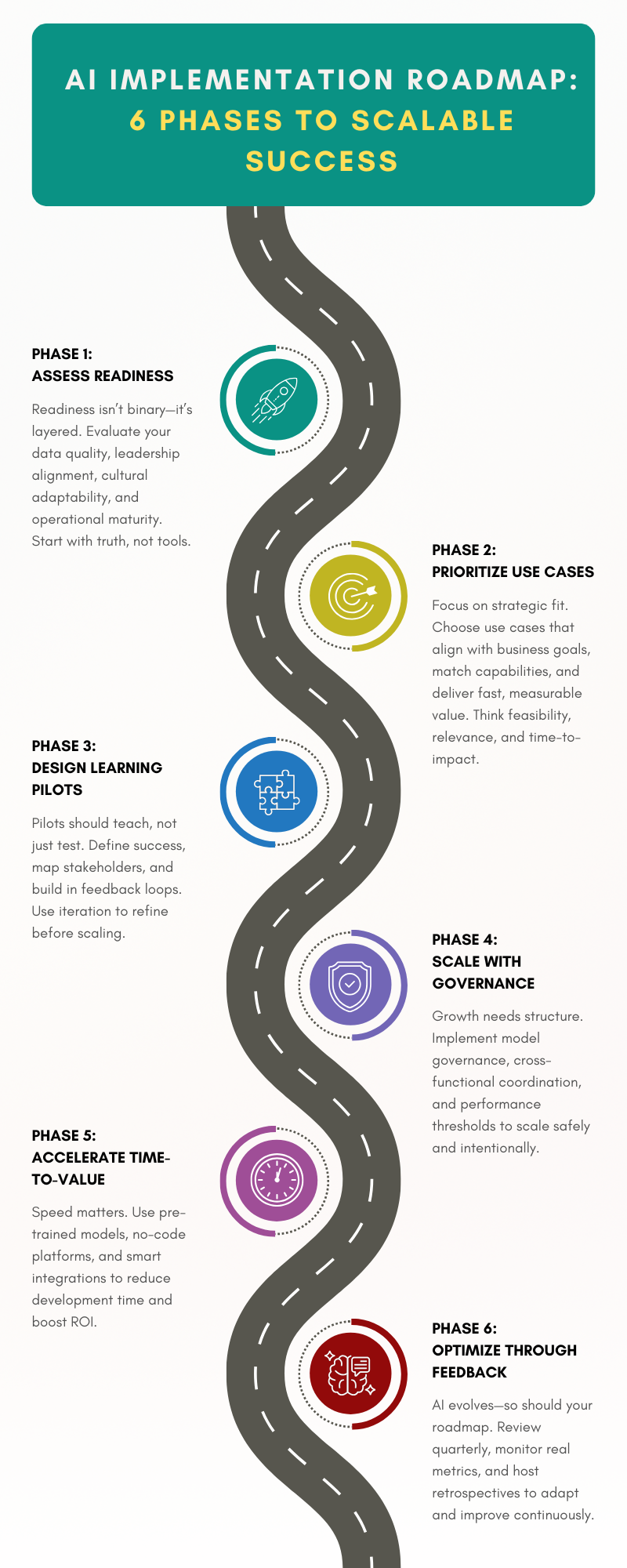AI Implementation Roadmap: A Strategic Framework for Real-World Impact
From readiness to rollout, this modular roadmap helps organizations transition from experimentation to scalable, measurable AI success.
Why Many AI Projects Fall Short and How to Build for Success
In 2025, 42% of companies discontinued most of their AI initiatives before reaching production, a significant increase from 17% the previous year. Meanwhile, only 5% of pilots delivered business results that justified further investment. These numbers, drawn from recent enterprise surveys and analyst reports, indicate a consistent breakdown: AI efforts often start without a clear system to guide them.
The main challenge is not technical complexity, but a lack of strategic alignment. Teams pursue ambitious use cases without addressing operational realities or necessary planning to scale. When results stall, support and momentum drop.
A well-structured AI implementation roadmap addresses these issues by connecting data, people, and priorities into a system that supports informed decision-making. Unlike a checklist, it adapts to your organization’s maturity and goals.
To connect vision and action, this guide outlines the framework and essential phases for progress from the outset. You will learn to assess readiness, prioritize use cases, design effective pilots, and scale solutions with governance and efficiency. Whether you advise clients or lead internal transformation, this roadmap supports practical execution. Let’s begin by defining what an AI implementation roadmap is.
What Is an AI Implementation Roadmap?
An AI implementation roadmap is a strategic framework guiding the introduction, testing, and scaling of artificial intelligence. It’s a modular system, adaptable to your environment, goals, and operational realities, rather than a fixed sequence.
Rather than focusing on tools or trends, the roadmap helps teams answer foundational questions:
- Where does AI create the most value?
- What needs to be in place before deployment?
- How do we measure success and avoid common pitfalls?
It’s designed to support decision-making at every stage, from early exploration to enterprise-wide rollout. While every organization’s path will look different, the roadmap provides structure where it’s needed most: aligning strategy, data, and execution. Next, we break down what this guide covers and how the phases fit together.
What This Guide Covers
The following sections break down the roadmap into six core phases. Each one reflects a critical part of the AI journey, from assessing readiness to optimizing performance. You can use them in sequence or as standalone tools, depending on your current implementation stage.
To begin your journey, focus first on the foundation: assessing your organization’s true readiness.

Readiness Isn’t Binary—It’s Layered
Every successful AI initiative starts with a clear assessment of the organization’s current standing. Readiness isn’t yes-or-no; it’s a layered evaluation across data, leadership, culture, and operations.
Begin with data. Is it clean, connected, and accessible? Fragmented systems or inconsistent formats hinder even the best models. Then check leadership. Are decision-makers aligned on goals, risk, and success? Without clarity, priorities shift and momentum fades.
Cultural adaptability matters just as much. Teams that resist change or fear automation often slow progress, not because they lack skill, but because they lack trust. Finally, assess operational maturity. If core workflows are broken or undocumented, AI will only amplify the noise.
The AI implementation roadmap begins here, not with tools but with truth. Knowing where you stand makes it easier to decide where to go next. Once readiness is understood, the focus shifts to prioritizing AI use cases that will yield strategic value.
Prioritize Use Cases by Strategic Fit
Not every AI use case deserves a green light. Some may appear promising but require excessive data, customization, or organizational change. Others may offer quick wins but lack significant impact.
The key is strategic fit. Choosing use cases that align with business goals, match capabilities, and deliver value fast enough to build support. Think feasibility, relevance, and time-to-impact.
For example, automating invoice processing can deliver measurable savings within weeks, while developing a custom recommendation engine may take months with uncertain outcomes. The roadmap helps teams focus on initiatives that drive meaningful business progress. After prioritization, it’s time to design pilots that not only test but also deepen organizational learning.
Design Pilots That Learn, Not Just Prove
A pilot isn’t just a test; it’s a learning engine. It should be scoped to reveal what works, what breaks, and what needs to evolve before scaling.
Start with clear inputs and outputs. Define what success looks like and how it will be measured. Map out stakeholders who own the process, who use the results, and who decides what happens next. Build in fallback plans for data gaps, workflow changes, or unexpected outcomes.
Most importantly, schedule iteration. Pilots without feedback often fail without clear reasons, while those with feedback loops provide a foundation for more informed and effective decisions. Pilots complete, the next critical step is ensuring effective scale through robust governance.
Scale with Governance, Not Just Enthusiasm
Scaling AI isn’t about copying what worked; it’s about building systems that support it. That means governance, coordination, and performance thresholds.
Model governance includes bias checks, audit trails, and retraining protocols. Cross-functional coordination ensures IT, operations, and compliance teams are aligned. And performance thresholds define when to expand, when to pivot, and when to pause.
Without these controls, scaling AI can introduce risk more quickly than it delivers value. The roadmap incorporates these measures early to ensure growth is intentional and well-managed. The key point is that robust governance at the scaling stage protects value and mitigates risk. Now, with governance in place, attention turns to accelerating the return on AI investments.
Accelerate Time-to-Value
Speed matters. Long timelines erode support and delay impact. But acceleration doesn’t mean cutting corners; it means making smart choices.
Use pre-trained models when possible. Leverage no-code platforms to reduce development time. Focus on integrating AI with existing systems rather than building from scratch.
According to IDC, organizations that align AI initiatives with operational KPIs see a 2.5x faster return on investment. This efficiency provides a strategic advantage. The final phase focuses on how organizations can sustain improvements with ongoing optimization and feedback.
Optimize Through Feedback, Not Assumptions
AI isn’t static. Models drift. Data evolves. Business goals shift. That’s why optimization isn’t a phase; it’s a mindset.
Schedule quarterly roadmap reviews. Monitor performance dashboards tied to real metrics. Host cross-functional retrospectives to surface blind spots and new opportunities.
The roadmap continues beyond deployment, adapting and improving alongside the organization. This approach ensures AI remains relevant and consistently delivers value. These principles underpin sustained AI success and help organizations realize the full benefit of their efforts.
AI Success Relies on Structured Systems
AI requires structure, alignment, and continuous improvement. The AI implementation roadmap adapts to your environment, supporting informed decisions and measurable outcomes.
Across industries, organizations that achieve results are executing with clarity. They have established frameworks that connect strategy to action and work with teams who understand how to deliver operational value through AI.
At AI InnoVision, we help businesses, nonprofits, and agencies move from pilot challenges to successful deployment. Our approach is grounded in experience, shaped by impact, and tailored to leaders’ realities.
If your goal is to accelerate effective, purpose-driven AI execution, our team is prepared to support your enterprise transformation.




